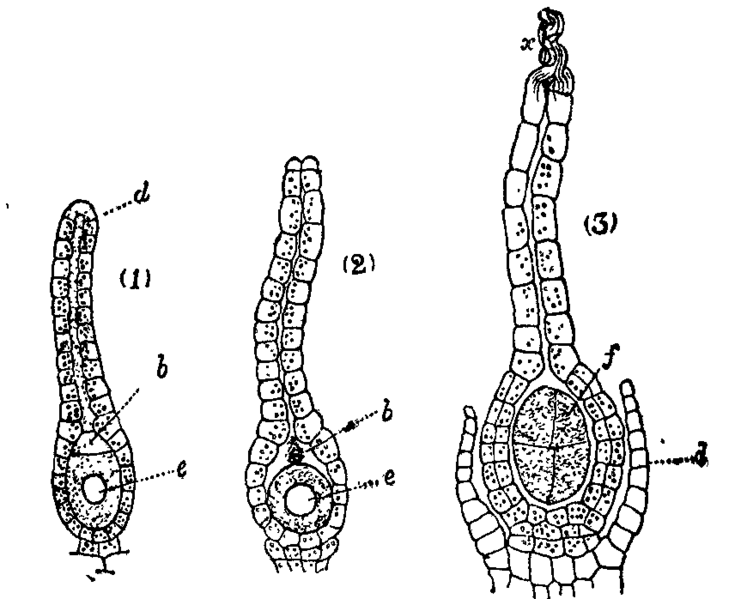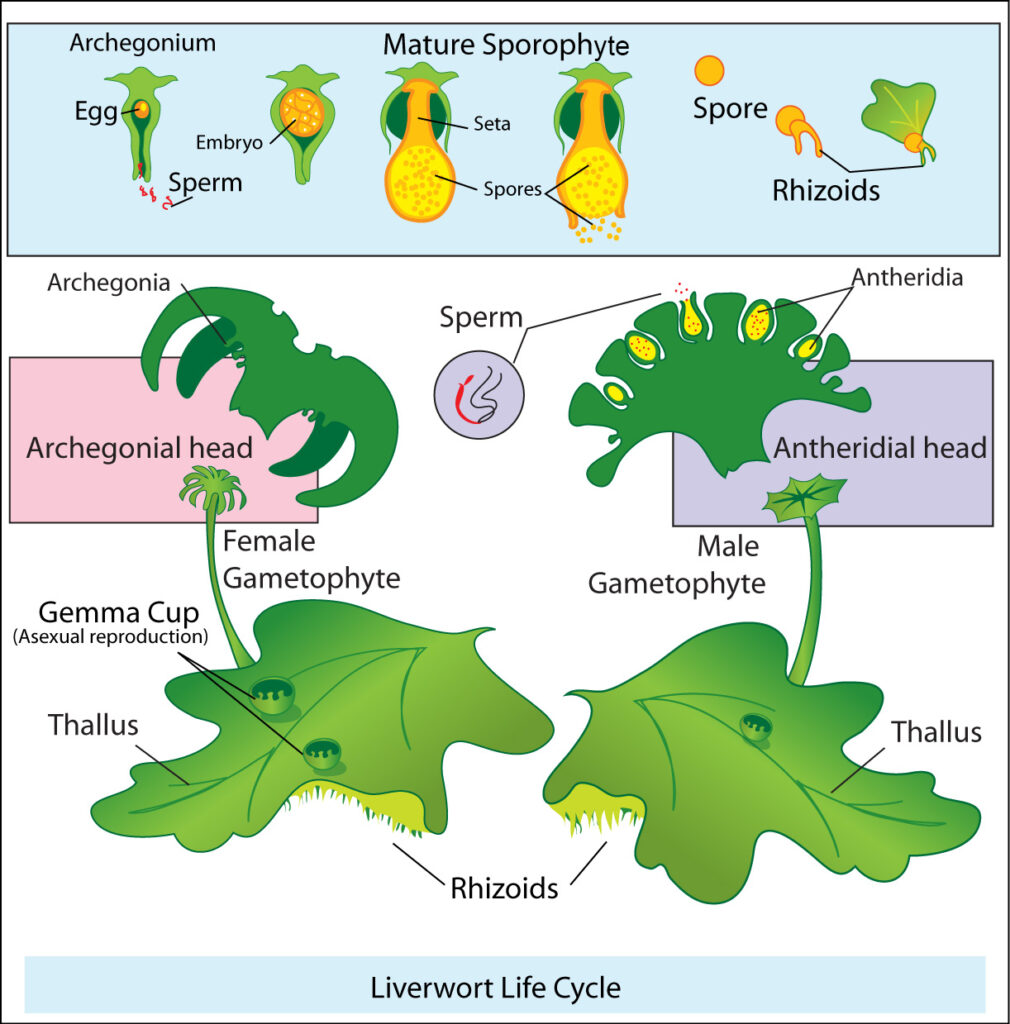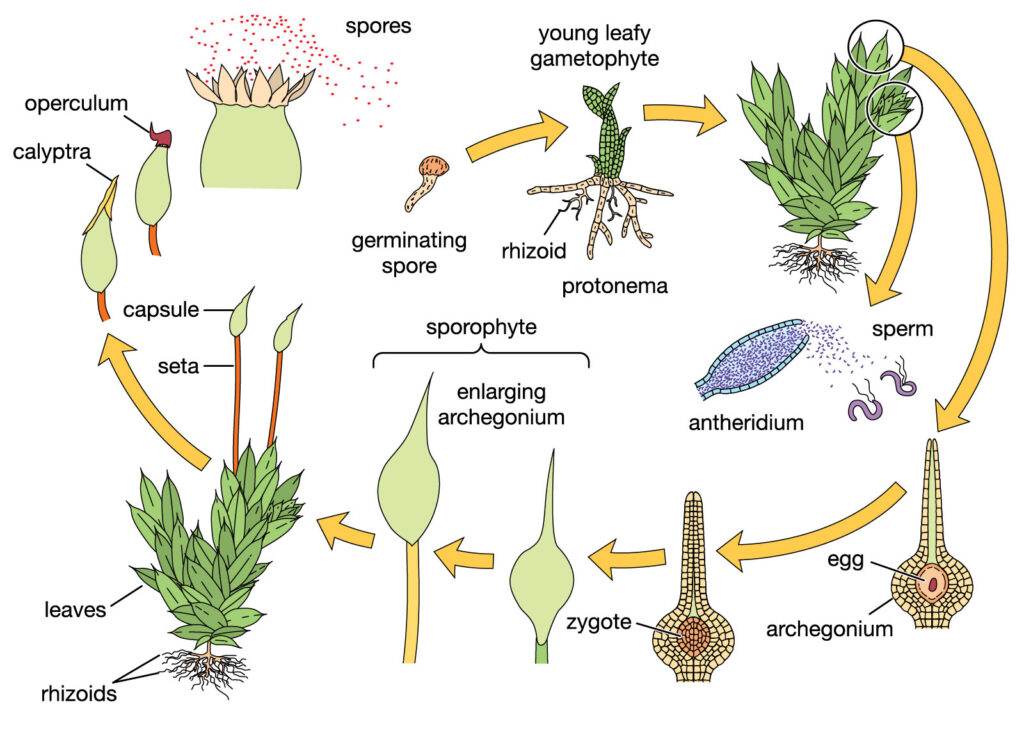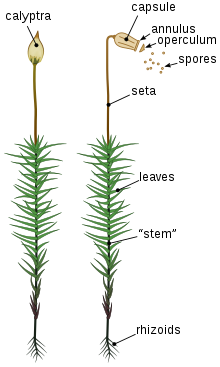ECONOMIC IMPORTANCE OF BRYOPHYTES
Bryophytes are non-vascular terrestrial plants of moist habitats in which a multicellular diploid sporophyte lives as a parasite on an independent multicellular haploid gametophyte.
The main characteristics of bryophytes are:-
- They are found commonly in damp, humid and shaded localities.
- The plants are small. They seldom attain great length or height.
- They are also called amphibians of the plant kingdom because these plants can live in soil but are dependent on water for sexual reproduction.
- The plant body is thallus-like and may be prostrate or erect. They lack true roots, stems or leaves but possess root-like, or stem-like structures. the plant body is attached to the substratum by unicellular or multicellular root-like structures called rhizoids.
- Vascular tissues i.e. xylem and phloem are absent.
- The dominant phase or the main plant body is a free-living gametophyte.
- Gametophyte is the haploid stage of a plant that generates gametes by the process of mitosis, hence is called as gametophyte.
- The gametophyte of bryophyte has muticellular sex organs, The male sex organ is called anthridium and the female sex organ is flack-shaped called archegonium.
Antheridium is surrounded by a sterile jacket which encloses mass of sperm mother cells/androcytes which produce two bifflagellated antherozoids (motile male gametes). Archegonium is flask-shaped with tubular neck and swollen venter. Just like antheridium, female sex organ is also surrounded by a jacket. Venter cavity possesses a sterile venter canal cell and a fertile egg. Neck encloses a few sterile neck canal cells.
- An external layer of water is esential for the swimming of antherozoids to the archegonia.
- Fertilisation produces zygote that is formed inside the archegonia. Zygotes do not undergo reduction division(meiosis) immediately instead they undergo mitotic division to form the embryo which develop further into diploid sporophyte. They are first embryophytes.
- The sporophyte is not free-living but attached to the photosynthetic gametophyte and derives nourishment from it.
- The sporophyte of bryophytes consists of three parts namely capsule, seta, and foot. Inside the capsule, the spore mother cells undergoes melosis to produce haploid spores (sporic melosis).
- Bryophytes are homosporous i.e they produce only one type of spores.
- The spores get disseminated by wind. As the air shakes the capsules, the spores come out and are dispersed. Spores have the ability to germinate immediately after falling on the suitable substratum.
- When the spores fall on a suitable substratum, they germinate either directly into the thalloid gametophyte (as in liverworts) or through a filamentous stage called protonema (as in mosses).
- Vegetative reproduction occurs through fragmentation, gemmae, and budding. The bryophytes are divided into liverworts and mosses

LIVERWORTS
- The plant body of liverwort is thalloid as in Marchantia. Thethallus is dorsiventral and closely appressed to the substratum. The leafy members like Porella have tiny leaf-like appendages in two rows on the stem like structure.
- Asexual reproduction occurs by means of fragmentation or by the formation of specialized structures called gammae (sing-gemma), Gemmae are green, multicellular asexual buds which develop in small receptacles called gemma cups located on the thalli. Mature gemmae become detached from the parentbody and germinate to from new individual.
- During sexual reproduction the sex organs are produced either on the same (Riccia) or on different thalli (Marchantla). In Marchantia sex organs are present on stalked receptacles. The male sex organs are present on antheridiophore and female sex organs are are borne on the archegoniophore.

MOSSES
- The predominant stage of the life cycle of a moss is the gametophyte which consists of protonema and leafy stages.
- The plant body is a leafy gametophyte which has multicellular and branched rhizoids.They consists of upright, slender axis bearing spirally arranged leaves. This stage bears the sex organs.
- The sex organs antheridia and archegonia are produced at the leafy shoot. The sex organs are present on the same plant but on different branches.
- The mosses have an elaborate mechanism of spore dispersal.
- The spores on liberation germinate into a creeping, green, branched and frequently filamentous stage called protonema (juvenile stage).
- Vegetative reproduction in mosses is by fragmentation and budding in the secondary protonema. Leafy stage develops from the secondary protonema as a lateral bud.


ECONOMIC IMPORTANCE OF BRYOPHYTES
(i) Prevention of soil erosion:- Bryophytes, especially mosses, form dense mats over the soil and prevent soil erosion against falling rains.
(ii) Soil formation:- Mosses are an important link in plant succession on rocky areas. They take part in building soil in rock crevices formed by lichens. Growth of Sphagnum (Bog moss) ultimately fills ponds and lakes with soil.
(iii) Water retention:- Dry Sphagnum has great water absorbing capacity. This characteristic is employed by gardeners to keep seeding and cut plants moist during transportation and propagation. Sphagnum moss was used in place of absorbent cotton, so it is also called cotton moss.
(iv) Peat:- Sphagnum often grows in acidic marshes. The older dead parts of moss and other marshy plants got slowly carbonised, compressed and fossilised over thousands of years and have produced a dark spongy mass called peat. Peat is dried, compressed and cut to form blocks. The peat blocks are used as fuel. Peat is also a good manure. It overcomes soil alkalinity and increase its water retention as wellas aeration.
(v) Other uses:- In rocky and ice cold areas mosses are a good source of food for certain animals like birds. A decoction of polytrichum commune was employed in removing kidney stones
FUNFACTS
Ancient Lineage: Bryophytes are some of the oldest land plants, dating back hundreds of millions of years. They represent an evolutionary transition from aquatic algae to terrestrial plants and played a crucial role in the colonization of land by plants.
Water Absorption: Bryophytes lack true vascular tissues, so they absorb water and nutrients directly through their cells. This makes them highly dependent on moist environments for survival, which is why they are commonly found in damp habitats like forests, bogs, and stream banks.
Miniature Forests: Mosses, a type of bryophyte, often form dense mats or cushions that resemble miniature forests. These moss communities provide habitat and food for a wide range of microorganisms, insects, and small animals.
Bioindicator Species: Bryophytes are sensitive to changes in environmental conditions and are often used as bioindicators of ecosystem health. Changes in bryophyte populations can signal environmental disturbances such as air pollution, climate change, or habitat degradation.
Survival Strategies: Bryophytes have developed various survival strategies to cope with harsh environmental conditions. Some species can tolerate desiccation and rehydrate when moisture becomes available, while others can enter a dormant state during dry periods and resume growth when conditions improve.
Reproduction without Water: While bryophytes rely on water for sexual reproduction, some species have evolved adaptations to reproduce without it. For example, certain mosses can produce specialized structures called gemmae, which are small, multicellular propagules capable of dispersing and developing into new plants.
Medicinal Uses: Bryophytes have been used in traditional medicine for centuries due to their medicinal properties. Some species contain bioactive compounds with anti-inflammatory, antimicrobial, and antioxidant properties, which have been used to treat various ailments.
Aesthetically Pleasing: Bryophytes are often appreciated for their beauty and aesthetic appeal. Their diverse forms, colors, and textures make them popular subjects for botanical art, photography, and terrarium gardening.
Carbon Storage: Despite their small size, bryophytes can store significant amounts of carbon in their tissues. They play a role in carbon sequestration and contribute to the global carbon cycle, helping mitigate climate change.
Cryptogamic Crusts: In arid and semi-arid regions, bryophytes are part of cryptogamic crusts, which are complex communities of algae, lichens, and mosses that form a protective layer on the soil surface. These crusts help prevent soil erosion, improve soil fertility, and enhance water retention.

FAQs
Bryophytes are a group of non-vascular plants that include mosses, liverworts, and hornworts. They are some of the earliest land plants and typically grow in moist environments, such as forests, bogs, and rocky habitats.
Bryophytes lack vascular tissues (xylem and phloem) found in higher plants, which means they do not have true roots, stems, or leaves. Instead, they have simple structures for absorption and photosynthesis. Bryophytes reproduce via spores and have a dominant gametophyte generation.
Bryophytes play crucial roles in ecosystems. They help stabilize soil, prevent erosion, and retain moisture. They also provide habitats and food for various organisms, contribute to nutrient cycling, and act as indicators of environmental quality.
While bryophytes lack some of the features commonly associated with “true” vascular plants, such as roots, stems, and leaves, they are considered to be part of the plant kingdom. They represent an important evolutionary transition from aquatic algae to terrestrial plants.
Yes, bryophytes have several economic uses. Some species are used in traditional medicine for their medicinal properties. Others are used in horticulture as decorative plants or for landscaping. Additionally, bryophytes are important in ecological restoration efforts and scientific research.